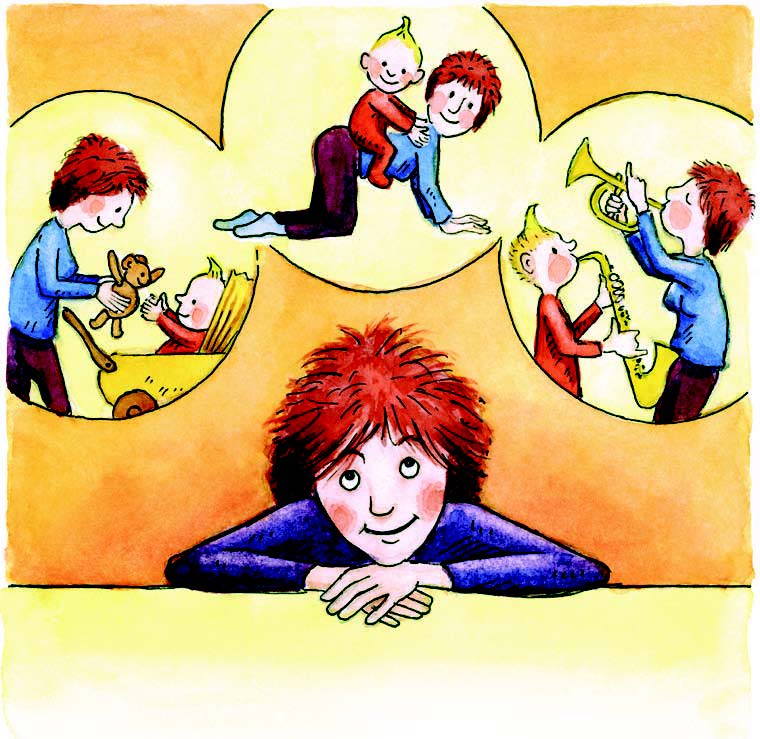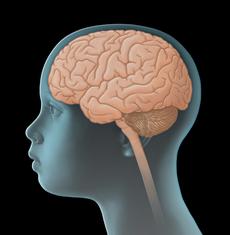Choroid plexus tumours - Brief information
Choroid plexus tumours are very rare tumours of the central nervous system (CNS tumours). This text provides information about the characteristics and subtypes of the disease, its frequency, causes, symptoms, diagnosis, treatment planning, treatment, and prognosis.
Author: Maria Yiallouros, Editor: Maria Yiallouros, Reviewer: PD Dr. Uwe Kordes, Dr. rer. nat. Stefan Hartung, English Translation: Dr. med. habil. Gesche Tallen, Last modification: 2021/09/01
Table of contents
General information on the disease
Tumours of the choroid plexus, also known as choroid plexus tumours (CPT), are very rare tumours of the central nervous system (CNS). They arise from a brain tissue, the choroid plexus, which coats the fluid-filled cavities (ventricles) of the brain. Choroid plexus tumours most frequently occur within the lateral ventricles in the cerebrum, but the third ventricle in the midbrain as well as the fourth ventricle close to the brain stem can be origins of tumour growth.
Both benign and malignant choroid plexus tumours exist. Depending on the degree of malignancy as defined by the World Health Organisation (WHO classification), the following grades of choroid plexus tumours are differentiated:
- (benign) choroid plexus papilloma (CPP, WHO grade I)
- (intermediate grade) atypical choroid plexus papilloma (APP, WHO grade II)
- (higher grade) choroid plexus carcinoma (CPC, WHO grade III)
All three types are comparably frequent. While choroid plexus papilloma type I and II mostly grow within the lateral ventricles, choroid plexus carcinoma tends to also invade adjacent brain tissue. All plexus tumours, including choroid plexus papilloma type I and II, can spread (metastasise) into the spinal cord via the cerebrospinal fluid (CSF) that fills the brain cavities and the spinal canal.
A typical first sign of a choroid plexus tumour is (due to its origin) associated hydrocephalus (see chapter „Symptoms“).
Incidence
Choroid plexus tumours account for about 0.5 % of all central nervous system (CNS) tumours in children and adolescents. Toddlers are most frequently affected, especially one year-olds, while the disease is rather rare in teenagers.
About 10 children and adolescents under 15 years of age are newly diagnosed with a choroid plexus tumour in Germany per year. This corresponds to an incidence of 1:1.000.000 children and adolescents (including all paediatric age groups). Since the incidence peaks in very young children, the proportion of plexus tumours among all CNS tumours is much higher in this age group, amounting, for example, to up to 13 % for children in their first year of life.
Causes
Choroid plexus tumours arise from altered cells of the brain tissue that coats the inner walls of the brain’s fluid-filled cavities (plexus choroideus). What is causing the (malignant) transformation of these cells still needs to be elucidated. It is known so far, however, that children and adolescents with certain hereditary diseases, such as Li-Fraumeni syndrome, have an elevated risk to develop a choroid plexus tumour, in particular choroid plexus carcinoma. But the disease often appears in patients without any hereditary disease, too.
Aside from hereditary factors, choroid plexus tumour cells (especially plexus carcinoma cells) often show modifications on certain genes or chromosomes. These modifications may lead to impaired cell development and dysfunctional communication between cells, thereby possibly contributing to the transformation of a healthy into a malignant cell. Such genetic alterations are usually not hereditary, they mostly happen early in development.
Symptoms
The major role of the plexus choroideus in the brain’s ventricles is to produce the cerebrospinal fluid (CSF), which protects brain and spine from trauma as well as provides it with nutrients. As plexus tumours derive from this tissue, they can produce this fluid as well – according to their volume to such an extent that it accumulates in the ventricles, thereby leading to a hydrocephalus. Hydrocephalus can also develop when the tumour blocks the circulation and/or drainage of the cerebrospinal fluid due to its location in the brain ventricles.
Depending on the patient’s age, the following general symptoms caused by increased production of cerebrospinal fluid may be present:
- Babies and toddlers with their soft spots (fontanelles) still open may show an abnormal head circumference (macrocephalus). Also, personality changes, moodiness, failure to thrive and neurological impairments (for example squinting, torticollis), being hyper-agitated and screaming without an obvious reason may be presenting symptoms of a brain tumour in young children.
- In children whose soft spot is already closed, the space-occupying tumour and/or the excess cerebrospinal fluid may cause increased intracranial pressure, thereby leading to headaches, backpain, drowsiness, loss of appetite, nausea and vomiting (particularly in the morning after getting up), weight loss, fatigue, problems concentrating as well as personality and mood changes.
Depending on the tumour’s location in the central nervous system (CNS), thus on which brain regions are being impaired by the tumour, so-called “region-specific” symptoms may also be observed. For example, a tumour growing within the brain hemispheres or in the midbrain can be associated with palsies and/or seizures, whereas typical symptoms of a tumour in the cerebellum or the brain stem are impaired balance and/or cranial nerve palsies. Symptoms like these can help the doctor to get an idea of the tumour site.
Good to know: Not all patients presenting with one or more of the symptoms mentioned above do have a choroid plexus or another type of brain tumour. Many of these symptoms can also occur with other, harmless diseases that are not associated with a brain tumour at all. However, if certain symptoms persist or worsen (for example repetitive headaches or rapid increase of head circumference in a young child), a doctor should be seen to find the underlying reason. In case it is a brain tumour, treatment should be started as soon as possible.
Diagnosis
If the doctor thinks that the young patient’s history and physical exam are suspicious of a tumour of the central nervous system (CNS), the patient should immediately be referred to a childhood cancer centre where further diagnostics can be initiated and performed by childhood cancer professionals. Very close collaboration between various specialists (such as paediatric oncologists, paediatric neurosurgeons, paediatric radiologists, to name a few) is required, both to find out whether the patient really suffers from a malignant CNS tumour and, if so, to determine the tumour type and the extension of the disease. Knowing these details is absolutely essential for optimal treatment planning and prognosis.
Tests to confirm diagnosis
The initial diagnostic procedures for a young patient presenting with a suspected CNS tumour at a childhood cancer centre include another assessment of the patient’s history, a thorough physical/neurological exam and diagnostic imaging, such as magnetic resonance imaging (MRI). These diagnostic tools help to confirm or rule out the presence of a CNS tumour and to determine a possible spread of the disease in other parts of the central nervous system, including the spinal canal. Also, tumour size and site, its extent with regard to the adjacent tissue, and a hydrocephalus can be assessed by these imaging techniques.
If in a baby or toddler magnetic resonance imaging (involving the use of a contrast agent) reveals a contrast-enhancing tumour in the region of the ventricles, a choroid plexus tumour can be suspected. Final confirmation of this diagnosis requires histological examination of a tumour sample, which is obtained during neurosurgical tumour removal (see chapter "Treatment”).
Tests to assess spread of the disease
Once the diagnosis of a choroid plexus tumour has been confirmed by histology, additional tests are required to assess the extent of the disease within the central nervous system (CNS). Apart from MRI scans of the complete CNS (brain and spine), these tests also include checking of the cerebrospinal fluid (CSF) for tumour cells. Cerebrospinal fluid is mostly obtained from the spine in the lower back (lumbar puncture).
Tests before treatment
Further tests prior to treatment include examination of the heart function by electrocardiography (ECG) and/or echocardiography (echo). Also, various blood tests serve to find out about the patient’s general health status and whether the functions of certain organs (such as the liver, kidneys and endocrine system) are intact, since if not, this needs to be considered before and during cancer treatment. Any changes occurring during the course of treatment can be assessed and managed better based on the results of those initial tests, which thus help to keep the risk of certain treatment-related side effects as low as possible.
Treatment planning
After diagnosis has been confirmed, therapy is planned. In order to design a highly individual treatment regimen for the patient, adapted to his clinical situation and risk of relapse, certain individual factors influencing the patient’s prognosis (called risk factors or prognostic factors) are being considered during treatment planning (risk-adapted treatment strategy).
The most relevant prognostic factor for patients with a choroid plexus tumour (CPT) is the (histological) type of the disease. It defines the tumour’s growth behaviour and, thus, its grade of malignancy (WHO-grade, see chapter “General Information on the Disease”). Therefore, the WHO-grade is the major factor to be considered when determining the optimal treatment plan for a patient with choroid plexus tumour. Also, checking for Li-Fraumeni syndrome is important; this rare hereditary cancer syndrome is usually associated with a less favourable prognosis for the patient and can affect family members. Furthermore, it requires special considerations for long-term follow-up of these patients.
Additional prognostic factors are the anatomical site, size and spread of the tumour as well as the extent of surgical removal and the response of the disease to chemo- and/or radiotherapy. Also, the patient’s age and clinical condition play an important role. Patient’s age at diagnosis particularly determines whether radiotherapy is an option or not. All these factors are considered in order to achieve the best possible outcome for every patient with choroid plexus tumour.
Treatment
Treatment of children and adolescents with a choroid plexus tumour (CPT) should take place in a children's hospital with a paediatric oncology program. Only such a childhood cancer centre provides highly experienced and qualified staff (doctors, nurses and many more), since they are specialised and focused on the diagnostics and treatment of children and teenagers with cancer according to the most advanced treatment concepts. The doctors in these centres collaborate closely with each other. Together, they treat their patients according to treatment plans (protocols) that are continuously optimised. The goal of the treatment is to achieve high cure rates while avoiding side and late effects as much as possible.
For patients with a choroid plexus tumour the tmajor treatment columns are surgery, chemotherapy and – depending on the patient’s age – radiation.
Important note: There is currently no open therapy trial for patients with choroid plexus tumour. The treatment options described in the following paragraphs are recommendations by the CPT trial/registry centre. They are based on the experiences and results obtained from the preceeding treatment study, which have been analysed by the Brain Tumour Group of the European Society for Paediatric Oncology (SIOP-E BTG) (see also chapter „Treatment Optimisation Trials and Registries“.) The individual treatment plan for each patient will be explained to you by your child’s doctor.
Surgery
First and major step in the treatment of a patient with choroid plexus tumour is surgery. The goal is to remove as much of the tumour as possible, since the extent of neurosurgical resection strongly impacts the subsequent course of the disease: the more of the tumour can be removed, the better the patient’s outcome. Therefore, if an initially only partially removed tumour turns out to be a choroid plexus tumour, the doctors will discuss the options of a second surgery in order to remove the remaining tumour tissue as well.
Watch-and-wait approach or non-surgical treatment
Following surgery, either close monitoring of the course of the disease (watch-and-wait approach) or subsequent (adjuvant) cancer treatment are the options, depending on the patient’s individual situation, which includes the histological type of tumour, the stage of the disease at diagnosis as well as the extent of surgical removal.
Monitoring (watch-and-wait)
Patients with a non-metastasised classic plexus papilloma (CPP, WHO-grade I) and patients after complete resection of an atypic plexus papilloma (APP, WHO-grade II) usually do not receive further treatment after neurosurgery. However, the doctors closely monitor the course of the disease (by regular magnet resonance imaging, MRI). Further treatment is only recommended if recurrent tumour growth occurs. But many patients remain tumour-free after only one surgery.
Non-surgical treatment after surgery (adjuvant therapy)
For patients with metastasised plexus papilloma (CPP, WHO-grade I), with incompletely removed atypical plexus papilloma (APP, WHO-grade II), or with plexus carcinoma (CPC, WHO-grade III), surgery alone is not enough. Since the risk of progressive disease or relapse, respectively, is very high in these patients, the doctors will recommend additional non-surgical treatment, such as a chemotherapy and, if possible, also radiotherapy.
With chemotherapy, the patient receives a combination of substances that inhibit cell growth, thereby stopping the tumour cells from growing or even killing them (cytostatic therapy). Radiotherapy uses highly energetic, electromagnetic radiation, which is usually given from a machine through the skin onto the tumour site, thereby causing DNA damage and subsequently death of the tumour cells. Aside from this so-called conventional radiotherapy, particle-radiation with protons (also known as proton therapy) can be an option for some patients as well. This type of radiotherapy provides the benefits of better targeting the tumour area, thus sparing more adjacent, healthy tissue from the effects of radiation. Proton therapy is gaining an increasing role in the treatment of children and teenagers with solid tumours.
Final decision with regards to the best treatment strategy for each individual patient especially takes into consideration the patient’s age at diagnosis as well as the histological tumour type. In general, all patients requiring adjuvant treatment (according to the criteria mentioned above) should receive chemotherapy. For patients with plexus papilloma as well as patients with metastasised atypical plexus papilloma, additional radiotherapy is recommended as long as they are older than three years at diagnosis.
Chemotherapy
Chemotherapy usually consists of a combination of different cytostatic agents (polychemotherapy) given over several treatment cycles. The standard chemotherapy regimen for patients with choroid plexus tumour includes a combination of the agents carboplatin, etoposide and vincristine, which are given every four weeks – for a total of six times – as an intravenous infusion (also known as systemic treatment). Depending on the individual disease situation, more treatment cycles as well as additional agents or different combinations are an option.
In rare situations, certain chemotherapeutic agents may be given directly into the ventricle (intraventricular therapy). Prior to this type of treatment, a brief neurosurgical procedure is required in order to temporarily implant a so-called Ommaya reservoir (a little cushion-like device of the size of a kidney bean) under the scalp. Via this device, the doctors can both give chemotherapy and take cerebrovascular fluid (CSF) for checking on / ruling out remaining tumour cells floating in the CSF.
Radiotherapy
Radiotherapy in addition to chemotherapy is recommended for all patients without Li-Fraumeni syndrome, who have reached three years of age and have been diagnosed with either plexus carcinoma (regardless of the presence of metastases) or with metastasised atypical plexus papilloma. Radiotherapy is usually scheduled after the first two chemotherapy cycles. After completion of radiotherapy, chemotherapy will be continued. Patients without metastasis usually receive radiation of the tumour site only (focal radiotherapy), while for patients with metastasised disease, radiation of the entire central nervous system (brain and spinal cord) is recommended in addition to the tumour site (craniospinal irradiation, CSI).
For patients with Li-Fraumeni syndrome, (conventional) radiotherapy is generally not recommended, but focal proton treatment (see above) may be an option.
Diagnostic tests during treatment: Diagnostic imaging (such as ultrasound and magnetic resonance tomography) as well as testing the cerebrospinal fluid are recommended at defined timepoints of treatment in order to assess the disease’s response to therapy. This helps to find out if treatment may require adjustment or can be continued as before.
Therapy optimising trials and registries
In Germany, children and adolescents with a choroid plexus tumor are usually treated according to the treatment plans (protocols) of therapy optimising trials or registries. Therapy optimising trials are controlled clinical trials that aim at improving current treatment concepts for patients based on the current scientific knowledge.
Patients who cannot participate in any study, for example because none is available or open for them at that time, or who do not meet the required inclusion criteria, respectively, may be included in a so-called registry. Such a registry pools patient data for further scientific analysis in order to acquire evidence-based information, based on which both current and future treatment strategies can be optimised and valid recommendations given. To ensure optimal treatment for patients not registered in a study, experts from assigned trial panels usually provide recommendations and advice to the local caregiver team.
A long-term international therapy optimising trial for the treatment of children and adolescents with choroid plexus tumours (CPT) was closed in 2010: trial CPT-SIOP 2000. There is currently no open trial for CPT-patients. However, all children and adolescents newly diagnosed with a choroid plexus tumour should be registered with the international CPT-SIOP Registry.
The treatment recommendations given by the principal investigators at the registry’s study centre are based on both the interim results obtained from trial CPT-SIOP 2000 and on the ongoing data-analyses within the registry. These show that after largest possible extent of tumour removal, many patients with choroid plexus tumour benefit from a chemotherapy, and also – depending on their age at diagnosis – from radiotherapy. However, after all, individual treatment planning is left to your child’s oncologist’s discretion.
The national registry- and trial-headquarters for CPT-patients are located at the University Children’s Hospital in Hamburg-Eppendorf, Germany, with PD Dr. Uwe Richard Kordes as the head.
Prognosis
The outcome (prognosis) of a patient with a choroid plexus tumour (CPT) mainly depends on the type of CPT. In particular for patients with malignant types of choroid plexus tumour, the biological behaviour and the spread of the tumour (presence or absence of metastasis) as well as the patient’s age at diagnosis, thus the option of radiotherapy, also play a major prognostic role.
Patients with classic plexus papilloma (CPP, WHO-grade I) usually have a very favourable prognosis with a five-year survival rate of up to 100 %. Also, patients with atypical plexus papilloma (APP, WHO-grade II) show good prognosis: their average five-year survival rate is – according to information provided by the CPP-SIOP Registry – about 95 %, with the outcome for less than 2-year-olds being a bit more favourable than for older children (100 % or 85 %, respectively).
Patients with plexus carcinoma have an average five-year survival rate of about 60 %, which, however, individually strongly depends on the success of surgery and the options of additional cancer therapy. For example, prognosis is better after radiotherapy than without. The risk of recurrent disease is high for patients with plexus papilloma. Nevertheless, there are currently a good number of long-term survivors of plexus carcinoma in Germany.
Note: The above-mentioned survival rates are statistical values. Therefore, they only provide information on the total cohort of patients with this kind of childhood brain tumour. They do not predict individual outcomes.
In the context of cancer, the term „cure“ should rather be referred to as „free of cancer“, because current treatment regimens may help getting rid of the tumour, but they are also frequently associated with numerous late-effects. Early detection and appropriate management of these long-term secondary effects typically require intensive rehabilitation and thorough long-term follow-up care, although a patient may have been „cured“ from the cancer.
Literatur 
- Fleischhack G, Rutkowski S, Pfister SM, Pietsch T, Tippelt S, Warmuth-Metz M, Bison B, van Velthoven-Wurster V, Messing-Jünger M, Kortmann RD, Timmermann B, Slavc I, Witt O, Gnekow A, Hernáiz Driever P, Kramm C, Benesch M, Frühwald MC, Hasselblatt M, Müller HL, Sörensen N, Kordes U, Calaminus G: ZNS-Tumoren. in: Niemeyer C, Eggert A (Hrsg.): Pädiatrische Hämatologie und Onkologie. Springer-Verlag GmbH Deutschland, 2. vollständig überarbeitete Auflage 2018, 359 [ISBN: 978-3-662-43685-1]
- Kaatsch P, Grabow D, Spix C: German Childhood Cancer Registry - Annual Report 2017 (1980-2016). Institute of Medical Biostatistics, Epidemiology and Informatics (IMBEI) at the University Medical Center of the Johannes Gutenberg University Mainz, 2018 [URI: www.kinderkrebsregister.de]
- Rutkowski S, Trollmann R, Korinthenberg R, Warmuth-Metz M, Weckesser M, Krauss J, Pietsch T: Leitsymptome und Diagnostik der ZNS-Tumoren im Kindes- und Jugendalter. Gemeinsame Leitlinie der Gesellschaft für Neuropädiatrie und der Gesellschaft für Pädiatrische Onkologie und Hämatologie 2016 [URI: www.awmf.org]
- Louis DN, Perry A, Reifenberger G, von Deimling A, Figarella-Branger D, Cavenee WK, Ohgaki H, Wiestler OD, Kleihues P, Ellison DW: The 2016 World Health Organization Classification of Tumors of the Central Nervous System: a summary. Acta neuropathologica 2016, 131: 803 [PMID: 27157931]
- Ruland V, Hartung S, Kordes U, Wolff JE, Paulus W, Hasselblatt M: Choroid plexus carcinomas are characterized by complex chromosomal alterations related to patient age and prognosis. Genes, chromosomes & cancer 2014, 53: 373 [PMID: 24478045]
- Schneider DT, Brecht IB, Olson ThA, Ferrari A (Eds): Rare Tumors In Children and Adolescents. Series: Pediatric Oncology, Springer-Verlag 2012 [ISBN: 978-3-642-04196-9]
- Wrede B, Hasselblatt M, Peters O, Thall PF, Kutluk T, Moghrabi A, Mahajan A, Rutkowski S, Diez B, Wang X, Pietsch T, Kortmann RD, Paulus W, Jeibmann A, Wolff JE: Atypical choroid plexus papilloma: clinical experience in the CPT-SIOP-2000 study. J Neurooncol 2009, 95: 383 [PMID: 19543851]
- Kühl J, Korinthenberg R: ZNS-Tumoren. In: Gadner H, Gaedicke G, Niemeyer CH, Ritter J (Hrsg.): Pädiatrische Hämatologie und Onkologie. Springer-Verlag 2006, 777 [ISBN: 3540037020]


 PDF Information on Choroid Plexus Tumours (458KB)
PDF Information on Choroid Plexus Tumours (458KB)



